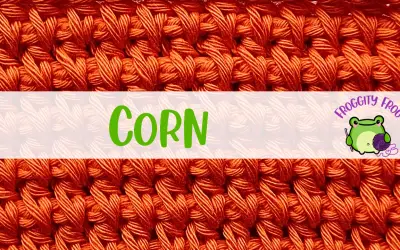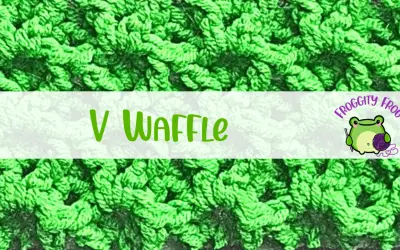The Celtic Weave stitch is one of the most stunning crochet stitches, but is probably one of the hardest crochet stitches too. It’s a beautiful cable stitch that looks like woven strands in a diagonal lattice and never fails to look fabulous.
I’ve seen some beautiful chunky throws made with this stitch, and they never fail to impress. I’ve also seen some beautiful sweaters made with it too and it is often used as an element in multi stitch projects to add an eye catching segment to the project.
This article contains affiliate links, I may receive a commission for purchases made through these links. As an Amazon Associate, I earn from qualifying purchases.
I first made the Celtic Weave stitch during my 50 Stitches crochet along. How could I not include this stunning stitch as one of the squares of my best known pattern?
This is a challenging stitch and I would most definitely class it as an advanced crochet stitch. It can be difficult to get a handle on the stitch placement, but I’ve found that if you can get through row 3, it becomes much easier after that point. Keeping track of your skipped stitches is important and working into them in the proper order is essential to successfully creating this beautiful crochet stitch.
This how to guide is part of Froggity Frog’s Stitch Vault collection. Have you seen all the other stitches in there? You can take a look here all the guides are free to access and maybe you will discover some new stitches to create for yourself.
The yarn I used in this stitch guide is Stylecraft Cotton Classique DK, a 100% cotton yarn. It’s a non mercerised cotton that is lovely and soft, but it can get a bit splitty if you frog it a couple of times. It does makes lovely cosy blankets though and is the yarn that got me hooked on cotton as my fibre of choice. I think I first got a ball of this yarn in a mystery bag I got off ebay, and it was a great yarn discovery for me.
I also used my trusty Clover Amour hooks which are perfect if you are looking for a good value ergonomic crochet hook that won’t cause your hand to ache if you are crocheting for long periods of time. I’ve tried many different crochet hooks over the years, but I always end up coming back to my trusty Clovers. They just sit so well in my hand and never let me down.
The Celtic Weave Stitch Pattern
Abbreviations
This stitch guide is written in US terms
- Ch = Chain
- St = Stitch
- Dc = Double Crochet
- Fptr = Front Post Treble Crochet
- Bptr = Back Post Treble Crochet
For the Celtic Weave stitch you need to make a foundation chain in multiples of 4 plus 2 (plus another 2 for your turning chain)
Row 1. In the 4th chain from your hook make a dc (your turning chain counts as your first stitch of the row) . Make a dc in each chain across.
Row 2. Turn and chain 1. Make a dc turning chain in the first stitch. *Skip the next 2 stitches and then make a front post treble crochet (fptr) in each of the next 2 stitches. Go back to the 2 skipped stitches and make a front post treble crochet in the first skipped stitch, working in front of the previous stitches, then make another in the second skipped stitch*
Repeat between *and* then make a dc in the last stitch of the row.
Your front post stitches that are sitting at the front should all slanting in the same direction. If they are not, you have got your stitch placement wrong and need to frog and remake the row.

Row 3. Turn and chain 1. Make a dc turning chain in the first stitch. Make a back post treble crochet (bptr) around the next two stitches. *Skip the next 2 stitches and make a bptr around the next 2 stitches. Go back to the skipped stitches and make bptrs first around the first skipped stitch, then around the 2nd. You need to work behind the first 2 bptr you made so that you start creating the woven effect*
To get to the skipped stitches you will need to work in front of the previous stitches. If you’re not sure how to do this I recommend watching this video here. You will find this part around 9 minutes in.
Repeat between *and* ending with 2 bptr around the last 2 fptr in the row below, then dc in the last stitch of the row.
Remember that all of the texture of this stitch is on one side. This means that all of your front and back posts stitches should lie on the front of your piece.
You may find it useful to keep flipping row 3 over to check your stitch placement to see that you are working your stitches in the right place. The problem with back post stitches is that you can’t see how it looks without turning things over.


Repeat rows 2 and 3 until you reach the number of rows you need for your project. You can then cut off and weave in your ends.
The Celtic Weave stitch does tend to tighten up and feels like it works up smaller than you expect. All of those front and back post stitches cause this. It’s also a yarn eater of a stitch as essentially it is double thickness due to all of the stitches criss crossing each other. So expect the Celtic Weave stitch to need more yarn than you might initially expect.
You can find more free crochet stitch guides here in Froggity Frog’s stitch vault. Come on over to our Facebook group – Froggity Frog’s Ribbit And Stitch and show us what you made with the Celtic Weave stitch. I’d love to see what you created.
Don’t forget to sign up to our newsletter to be the first to know about new stitch guides and new crochet pattern releases. You can sign up here and be the first to see what I’ve got cooking behind the scenes here at Froggity Frog.






0 Comments